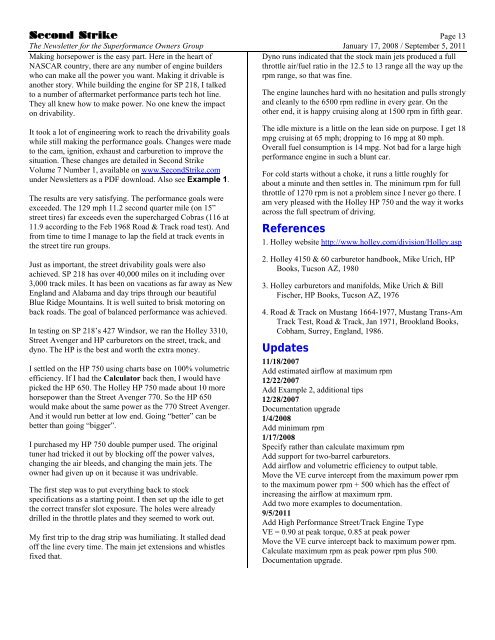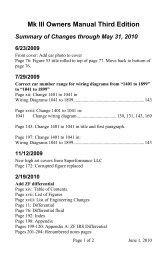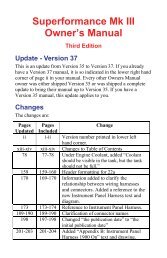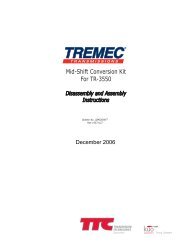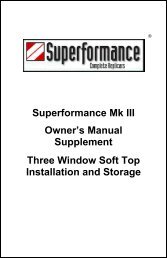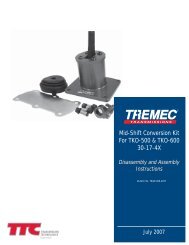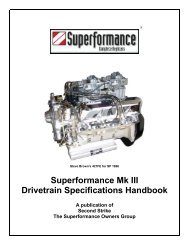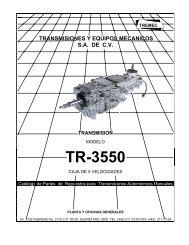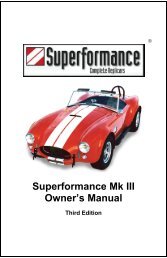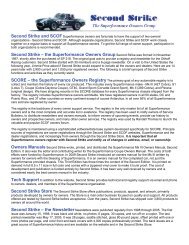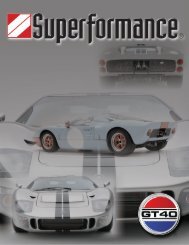Carburetor Calculator - Second Strike
Carburetor Calculator - Second Strike
Carburetor Calculator - Second Strike
You also want an ePaper? Increase the reach of your titles
YUMPU automatically turns print PDFs into web optimized ePapers that Google loves.
<strong>Second</strong> <strong>Strike</strong> Page 13<br />
The Newsletter for the Superformance Owners Group January 17, 2008 / September 5, 2011<br />
Making horsepower is the easy part. Here in the heart of<br />
Dyno runs indicated that the stock main jets produced a full<br />
NASCAR country, there are any number of engine builders throttle air/fuel ratio in the 12.5 to 13 range all the way up the<br />
who can make all the power you want. Making it drivable is rpm range, so that was fine.<br />
another story. While building the engine for SP 218, I talked<br />
to a number of aftermarket performance parts tech hot line.<br />
The engine launches hard with no hesitation and pulls strongly<br />
They all knew how to make power. No one knew the impact and cleanly to the 6500 rpm redline in every gear. On the<br />
on drivability.<br />
other end, it is happy cruising along at 1500 rpm in fifth gear.<br />
It took a lot of engineering work to reach the drivability goals<br />
while still making the performance goals. Changes were made<br />
to the cam, ignition, exhaust and carburetion to improve the<br />
situation. These changes are detailed in <strong>Second</strong> <strong>Strike</strong><br />
Volume 7 Number 1, available on www.<strong>Second</strong><strong>Strike</strong>.com<br />
under Newsletters as a PDF download. Also see Example 1.<br />
The results are very satisfying. The performance goals were<br />
exceeded. The 129 mph 11.2 second quarter mile (on 15”<br />
street tires) far exceeds even the supercharged Cobras (116 at<br />
11.9 according to the Feb 1968 Road & Track road test). And<br />
from time to time I manage to lap the field at track events in<br />
the street tire run groups.<br />
Just as important, the street drivability goals were also<br />
achieved. SP 218 has over 40,000 miles on it including over<br />
3,000 track miles. It has been on vacations as far away as New<br />
England and Alabama and day trips through our beautiful<br />
Blue Ridge Mountains. It is well suited to brisk motoring on<br />
back roads. The goal of balanced performance was achieved.<br />
In testing on SP 218’s 427 Windsor, we ran the Holley 3310,<br />
Street Avenger and HP carburetors on the street, track, and<br />
dyno. The HP is the best and worth the extra money.<br />
I settled on the HP 750 using charts base on 100% volumetric<br />
efficiency. If I had the <strong>Calculator</strong> back then, I would have<br />
picked the HP 650. The Holley HP 750 made about 10 more<br />
horsepower than the Street Avenger 770. So the HP 650<br />
would make about the same power as the 770 Street Avenger.<br />
And it would run better at low end. Going “better” can be<br />
better than going “bigger”.<br />
I purchased my HP 750 double pumper used. The original<br />
tuner had tricked it out by blocking off the power valves,<br />
changing the air bleeds, and changing the main jets. The<br />
owner had given up on it because it was undrivable.<br />
The first step was to put everything back to stock<br />
specifications as a starting point. I then set up the idle to get<br />
the correct transfer slot exposure. The holes were already<br />
drilled in the throttle plates and they seemed to work out.<br />
My first trip to the drag strip was humiliating. It stalled dead<br />
off the line every time. The main jet extensions and whistles<br />
fixed that.<br />
The idle mixture is a little on the lean side on purpose. I get 18<br />
mpg cruising at 65 mph; dropping to 16 mpg at 80 mph.<br />
Overall fuel consumption is 14 mpg. Not bad for a large high<br />
performance engine in such a blunt car.<br />
For cold starts without a choke, it runs a little roughly for<br />
about a minute and then settles in. The minimum rpm for full<br />
throttle of 1270 rpm is not a problem since I never go there. I<br />
am very pleased with the Holley HP 750 and the way it works<br />
across the full spectrum of driving.<br />
References<br />
1. Holley website http://www.holley.com/division/Holley.asp<br />
2. Holley 4150 & 60 carburetor handbook, Mike Urich, HP<br />
Books, Tucson AZ, 1980<br />
3. Holley carburetors and manifolds, Mike Urich & Bill<br />
Fischer, HP Books, Tucson AZ, 1976<br />
4. Road & Track on Mustang 1664-1977, Mustang Trans-Am<br />
Track Test, Road & Track, Jan 1971, Brookland Books,<br />
Cobham, Surrey, England, 1986.<br />
Updates<br />
11/18/2007<br />
Add estimated airflow at maximum rpm<br />
12/22/2007<br />
Add Example 2, additional tips<br />
12/28/2007<br />
Documentation upgrade<br />
1/4/2008<br />
Add minimum rpm<br />
1/17/2008<br />
Specify rather than calculate maximum rpm<br />
Add support for two-barrel carburetors.<br />
Add airflow and volumetric efficiency to output table.<br />
Move the VE curve intercept from the maximum power rpm<br />
to the maximum power rpm + 500 which has the effect of<br />
increasing the airflow at maximum rpm.<br />
Add two more examples to documentation.<br />
9/5/2011<br />
Add High Performance Street/Track Engine Type<br />
VE = 0.90 at peak torque, 0.85 at peak power<br />
Move the VE curve intercept back to maximum power rpm.<br />
Calculate maximum rpm as peak power rpm plus 500.<br />
Documentation upgrade.


